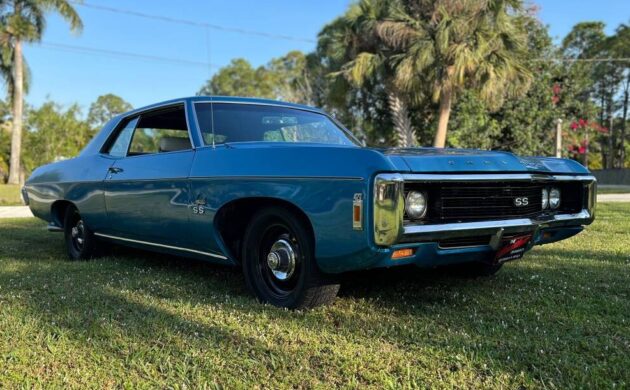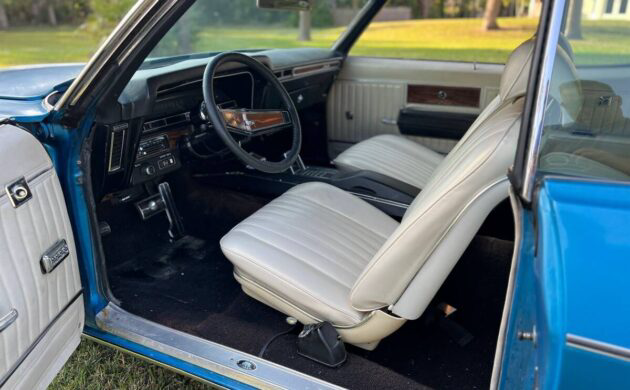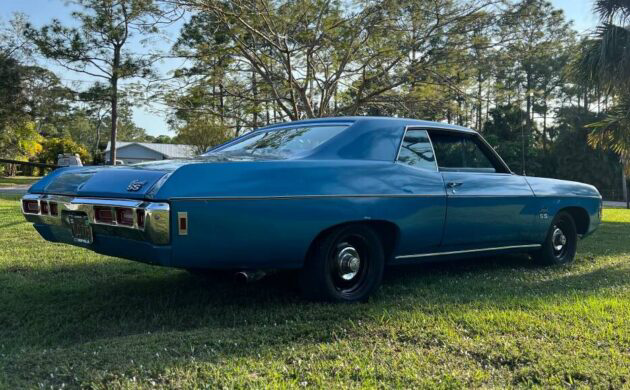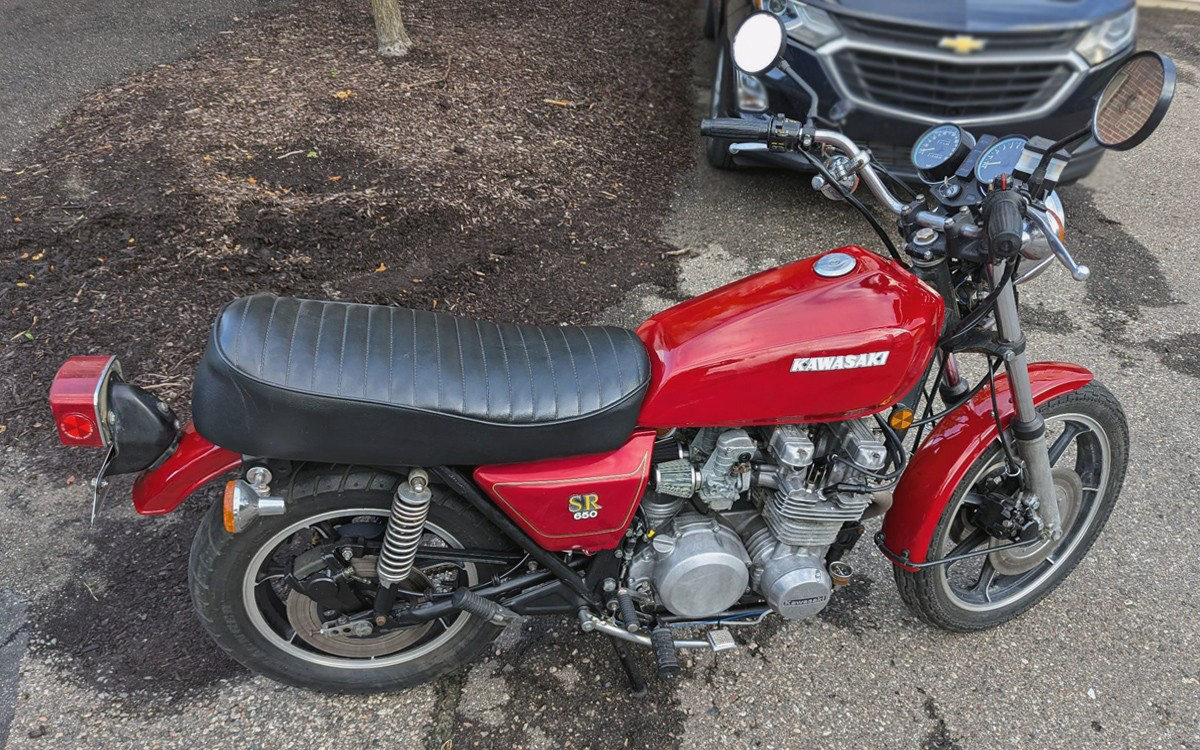The current automotive world is very different from the one in which many of us grew up. It is no longer possible to walk into a Chevrolet dealership and drive away in a car that will seat five people comfortably, has a cavernous trunk to swallow an enormous amount of luggage, and is powered by an engine that offers effortless open-road cruising but produces a beautiful V8 bass bellow and a push in the back when the driver nails the “loud” pedal. That is what this 1969 Chevrolet Impala SS 427 offers, with its only pressing need being a new home. The seller listed it here on Craigslist in Jupiter, Florida. If you hand them $29,900, you can become this classic’s next custodian. I must say a big thank you to Barn Finder Tony P for spotting the impressive Impala.
I always respect candid sellers, meaning I find a lot to like about this Impala. Its LeMans Blue paint makes a positive first impression, but the seller admits it would benefit from a buff. However, there are no signs of patchiness that might justify a repaint. It has a few flaws and marks, with this one above the passenger-side rear wheel arch appearing to be the worst. The panels are straight, with tight and consistent gaps. I combed the supplied photos thoroughly, only spotting a single sign of rust in one lower front fender. The seller indicates the Impala spent its life in California, which may help explain its excellent level of steel preservation. I always recommend an in-person inspection before potential buyer parts with their cash for a classic purchase, but this one shows immediate promise. The chrome and glass look good, while the Black Rally-style wheels and chrome center caps give the car a sleeper feel.
If a classic car is to tick all the right boxes with a purist, its numbers-matching status will sit high on the list. This Impala delivers on that front, retaining its original drivetrain components. And what a drivetrain it is! The engine bay houses the L36 version of Chevrolet’s mighty 427ci V8. This big-block feeds 390hp to the 12-bolt rear end via a three-speed Hydramatic transmission, while the SS features power steering and power brakes. The combination should allow this classic to storm the ¼-mile in 15.6 seconds, which isn’t bad for a car of this size weighing 4,197 lbs. The vehicle has spent significant time in storage and will require a thorough inspection before being considered roadworthy. However, the seller commenced the process by installing a new carburetor, alternator, and voltage regulator. It would be worth asking whether they retained the original components because their inclusion could contribute to this classic’s potential future value.
The brave original owner ordered this Impala with an interior trimmed white vinyl. Its condition is surprisingly good, with no significant wear or marks. It would benefit from a deep clean, but that is an enjoyable activity where the finished product should provide the new owner enormous satisfaction. The faux woodgrain on the door trims is worn, but the remaining trim and carpet show promise. The door trim cards may be slightly warped, but I’ve seen owners address this problem in a surprising way. The starting point is removing the trims and placing them face-down on a flat surface. Applying steam and weight carefully on the back side of the cards can remove most, if not all, of the warping. It costs nothing to try and provided the person performing the work is careful, they probably won’t make the matter worse. The headliner requires replacement, but the seller includes a correct reproduction one for the buyer to install. There is a column-mounted tach, but I can’t spot any further additions. For those craving luxury touches, this Chevy features air conditioning, power windows, a console, and a rear defroster
While it wears SS badges, this 1969 Impala could easily be classed as a sleeper. The black Rally-style wheels and chrome center caps provide no clues to the powerhouse lurking beneath the hood. Its needs are pretty minor, meaning the buyer could enjoy the car untouched this summer but could spend some constructive hours in their workshop addressing the shortcomings during the mercilessly long winter months. If you find that scenario impossible to resist, could you be tempted to contact the seller so the Impala finds a new home where it will be appreciated?










Looking this SS427 over, I like the nice mix of options. The C in the VIN tells that this was built in the Southgate plant – 20 minutes east of LAX.
Please don’t be deceived by that, and those Cali license plates – you might think this is rust free, but it is NOT.
The RH quarter panel looks like a ‘lemans blue mud pie’. Click on the picture above to see what mean. Same with the RH fender that JO mentions in the write up. Several years of dust and any leaves will accumulate inside the bottom of the fender, just behind the wheels. There is no where for it to go, and any moisture will not evaporate. Even a CA car can rust from the inside out. There is a reason this doesn’t have the factory wheel opening mouldings installed. They would fit poorly!
Check the engine and transmission codes to make sure it is a real SS427. This year is easy to fake. The only reason I say that because the SS badges are not in the correct (trunk) or precise (fender) locations. But – that could be because the body shop didn’t know, or care.
And – the 427/390 HP air cleaner is one year only part. This is an open element version – standard for the 427/425 HP, and that wasn’t available with A/C.
This is my favorite year of the full size Chevys. I have owned over a dozen, and I want to make sure that buyers know what to look for when buying one. And if anyone here buys this – welcome to the family!
Thank you so much for the feedback, Big_Fun. Buying a classic can be a minefield, which is why I emphasize the need for an in-person inspection. There may not be any genuine issues, but I think we’ve all read stories where a buyer has been burned, and nothing beats seeing a car in the flesh.
I also appreciate the information you furnished about the Impala range. There’s nothing like hearing from someone who has hands-on experience as an owner to gain clear insight. When cars like this Impala were worth virtually nothing during the 1970s and early 1980s, many were modified, and separating something genuine from a clone is challenging. I hope you continue enjoying our articles, and I look forward to reading (and learning from) your future comments. Cheers, Adam.
Adam –
Always glad to help. I apologize for thinking JO did the writing, I just read one of his. Your passion for classic autos is appreciated.
The more I look, the more oddities I see. The RH SS fender badges are upside down – the LH side – one up, one down. See the picture above. I turned the picture 180 degrees! Turn your phone upside down, then you’ll see what I mean.
Those quarters may be aftermarket – at least the right side. The bodyside mouldings are, for sure. All the SS badges are repoduced, even for the steering wheel horn shroud.
I amost think the RH fender has a ‘pinch’ mark at the bottom from the arm of a two post lift.
And finally – that radiator is a big block for ’65 to ’68 – the offset filler neck is the clue. ’69 has filler neck in the middle, and the ‘long’ water pump design. I wonder if there is a fan shroud. when I put a ’69 radiator in a ’66, the ’66 shroud didn’t work. So, I used the ’69 shroud – upside down!
Chevy made almost four times as many 335hp 427 engines vs. the 390hp 427. I have seen a few 335hp Impalas on the net disappear for a few years, then come back as SS427 cars.
And it’s posted twice (on the same page).
THAT explains why my first posted comment seemingly disappeared! :-)
The first thing I do when looking at a old car is feel the rear wheel wells. I have seen quarter panels literally built out of bondo and duraglass. Thick from the edge up into the wheel housing, wide and sloppy where the mouldings attach. It doesn’t take much to clean up the edges. In person inspections can save you from making a disasterous mistake
This car needs way to much work for $30k. Quarters, fender, paint you are looking at $10k to start if unable to do yourself. Better ones are out there, cheaper
When I was a freshman in high school back in 1977 there was a green 69 SS in the school parking lot right by the studyhall/cafereria. It was jacked up with wide tires and I don’t remember now what it had for wheels but I lusted after that car.
When I ran a restoration shop, my body and paint guys all knew it was just as important that the wheel opening lip and the inner fender panel needed to look just as original as the outer fender surface. When I see a wheel lip edge as rough as this one is, I can only imagine how poorly repaired that fender is under the body putty. If someone isn’t willing or capable of ensuring the lip area is correct, I would reasonably expect the hidden repairs will be equal in quality.
While I’m delighted to see this car has Factory A/C and a high performance big block motor, that combination is actually pretty damn rare. Buyers looking for top-level [straight line] performance typically shunned A/C, and buyers who wanted A/C in a big block car were usually buying both for other reasons like towing a boat or RV trailer.
Big_Fun is correct in making sure the VIN and engine numbers are correct before shelling out $30,000. As he points out, there are far too many little red flags flappin’ in the breeze around this car. Unlike vintage MoPaR high performance cars that have a fender tag detailing exactly what version the car left the factory as, along with it’s option list, Chevrolet [& GM in general] simply listed the engine type by numbers of cylinders, so later changes and additions are more likely to be claimed as original equipment.